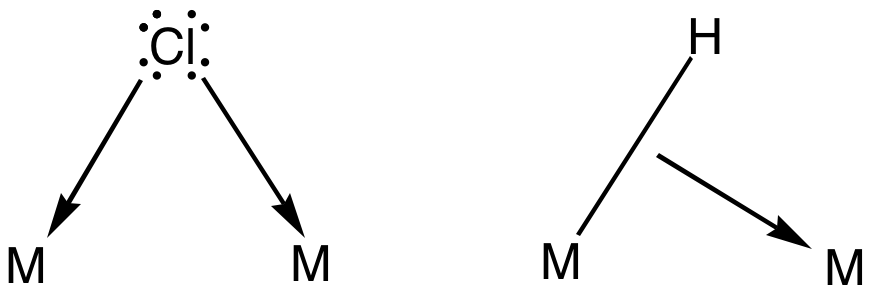Bridging ligand on:
[Wikipedia]
[Google]
[Amazon]
In
File:Ru-Cl.png, In this ruthenium complex (

coordination chemistry
A coordination complex consists of a central atom or ion, which is usually metallic and is called the ''coordination centre'', and a surrounding array of bound molecules or ions, that are in turn known as ''ligands'' or complexing agents. Many ...
, a bridging ligand is a ligand that connects two or more atoms, usually metal ions. The ligand may be atomic or polyatomic. Virtually all complex organic compounds can serve as bridging ligands, so the term is usually restricted to small ligands such as pseudohalides or to ligands that are specifically designed to link two metals.
In naming a complex wherein a single atom bridges two metals, the bridging ligand is preceded by the Greek letter mu, μ, with a subscript
A subscript or superscript is a character (such as a number or letter) that is set slightly below or above the normal line of type, respectively. It is usually smaller than the rest of the text. Subscripts appear at or below the baseline, whil ...
number denoting the number of metals bound to the bridging ligand. μ2 is often denoted simply as μ. When describing coordination complexes care should be taken not to confuse μ with η ('eta'), which relates to hapticity. Ligands that are not bridging are called terminal ligands.
List of bridging ligands
Virtually all ligands are known to bridge, with the exception ofamine
In chemistry, amines (, ) are compounds and functional groups that contain a basic nitrogen atom with a lone pair. Amines are formally derivatives of ammonia (), wherein one or more hydrogen atoms have been replaced by a substituent su ...
s and ammonia. Common bridging ligands include most of the common anions.
Many simple organic ligands form strong bridges between metal centers. Many common examples include organic derivatives of the above inorganic ligands (R = alkyl, aryl): , , , (imido), (phosphido, note the ambiguity with the preceding entry), (phosphinidino), and many more.
Examples
(benzene)ruthenium dichloride dimer
(Benzene)ruthenium dichloride dimer is the organoruthenium compound with the formula CH)RuCl This red-coloured, diamagnetic solid is a reagent in organometallic chemistry and homogeneous catalysis.
Preparation, structure, and reactions
The dime ...
), two chloride ligands are terminal and two are μ2 bridging.
File:Creutz-Taube-Ion.svg, Pyrazine is a bridging ligand in this diruthenium compound, called the Creutz–Taube complex
The Creutz–Taube ion is the metal complex with the formula 5+. This cationic species has been heavily studied in an effort to understand the intimate details of inner sphere electron transfer, that is, how electrons move from one metal complex t ...
.
File:Mu3 compound.png, In the cobalt cluster , the ligand is triply bridging, although this aspect is typically not indicated in the formula.
File:Fe3(CO)12lessFe-Fe.png, In triiron dodecarbonyl
Triiron dodecarbonyl is the organoiron compound with the formula Fe3(CO)12. It is a dark green solid that sublimes under vacuum. It is soluble in nonpolar organic solvents to give intensely green solutions. Most low-nuclearity clusters are pale ...
, two CO ligands are bridging and ten are terminal ligands. The terminal and bridging CO ligands interchange rapidly.
File:Niobium-pentachloride-dimer-2D.png, In NbCl5, there are two bridging and eight terminal chloride ligands.
File:Au6C(PPh3)6.png, The cluster features a μ6- carbide ligand, although again, the designator "μ" is not usually used.
File:Aluminium-trifluoride-3D-polyhedra.png, In rhenium trioxide, the oxide ligands are all μ2. These oxide ligands "glue" together the metal centres.
File:Zirconium-tetrachloride-3D-balls-A.png, In the case of , there are both terminal and doubly bridging chloride ligands.
File:Rhodium(II)-acetate-hydrate-dimer-from-xtal-1971-3D-balls.png, In rhodium(II) acetate
Rhodium(II) acetate is the coordination compound with the formula Rh2(AcO)4, where AcO− is the acetate ion (). This dark green powder is slightly soluble in polar solvents, including water. It is used as a catalyst for cyclopropanation of al ...
, the four acetate groups are bridging ligands.
File:VO(HPO4)0.5H2O.tif, In , pairs of vanadium(IV) centers are bridged by water ligands.
Bonding
For doubly bridging (μ2-) ligands, two limiting representation are 4-electron and 2-electron bonding interactions. These cases are illustrated in main group chemistry by and . Complicating this analysis is the possibility of metal–metal bonding. Computational studies suggest that metal-metal bonding is absent in many compounds where the metals are separated by bridging ligands. For example, calculations suggest that lacks an iron–iron bond by virtue of a 3-center 2-electron bond involving one of three bridging CO ligands.
Polyfunctional ligands
Polyfunctional ligands can attach to metals in many ways and thus can bridge metals in diverse ways, including sharing of one atom or using several atoms. Examples of such polyatomic ligands are the oxoanions and the related carboxylates, , and the polyoxometalates. Several organophosphorus ligands have been developed that bridge pairs of metals, a well-known example being {{chem2, link=dppm, Ph2PCH2PPh2.See also
*Bridging carbonyl
Metal carbonyls are coordination complexes of transition metals with carbon monoxide ligands. Metal carbonyls are useful in organic synthesis and as catalysts or catalyst precursors in homogeneous catalysis, such as hydroformylation and Reppe ch ...
References